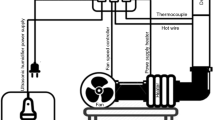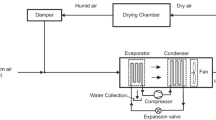Abstract
This study aimed to investigate the heat and mass transfer occurring during the drying process of chicken manure pellets in a modified portable horizontal rotary dryer, where hot air was employed as a heat source. The modified rotary dryer consisted of a drying pipe (1 m × 0.3 m i.d., thickness 3 mm) responsible for heat exchange and a 1/2-hp electric motor installed for power transmission through the pipe. Chicken manure pellets with an average diameter of 3–5 mm were utilized for the drying process with a feeding rate set at 10 kg/h. In the experiment, the hot air flow rate was kept constant at 0.25 kg/min with the inclination angle of the pipe set at 1º, drying temperatures at 30–85 ºC, and rotation speeds at 10–20 rpm. The results showed that the optimal drying condition was achieved at a temperature range of 70–85 ºC and the rotation speed at 10 rpm, which resulted in the heat load of 4.2 kW in the system corresponding to the heat of 2.87 kW used for the drying process. The drying rate was obtained at 4.85 kgwater/h and thermal efficiency at 68.43%, which could reduce the moisture of the manure pellets from 50%db to 18.55%db within 30–40 min. As with multiple regression analysis, there was a significant correlation between drying rate and manure moisture, moisture ratio, drying heat, and thermal efficiency, with the R2 values of 0.95, 0.97, 0.98, 0.95, and 0.94, respectively.








Similar content being viewed by others
Availability of data and material
Not applicable.
Code availability
Not applicable.
Abbreviations
- C pa :
-
Value of heat capacity of air (kJ/kg K)
- C ps :
-
Value of heat capacity of solids = 1.02 kJ/kg K
- L :
-
Value of latent heat of water evaporation = 2260 kJ/kg
- m :
-
Flow rate of solids (kg/s)
- m e :
-
Flow rate of flue gas at output point (kg/s)
- M 0 :
-
Initial moisture content (kgwater/kgdry matter)
- M e :
-
Equilibrium moisture content (kgwater/kgdry matter)
- M eq :
-
Solid equilibrium moisture content (kgwater/kgdry matter)
- M t :
-
Moisture content at time t (kgwater/kgdry matter)
- MC :
-
Moisture content (kgwater/kgdry matter)
- M in :
-
Initial solid mass (kg)
- M out :
-
Final solid mass (kg)
- MR :
-
Moisture ratio
- MR exp,i :
-
Experimental moisture ratio for the ith observation
- MR pre,i :
-
Predicted moisture ratio for the ith observation
- MR pre,avg :
-
Predicted average moisture ratio
- n :
-
Number of constants
- N :
-
Number of observations
- q d :
-
Amount of heat used in evaporating water from solids (latent heat) (kJ/s)
- q l :
-
Amount of heat loss to the environment (amount of heat loss from cylinder) (kJ/s)
- q s :
-
Amount of heat used in increasing solid temperature during drying process (kJ/s)
- Q :
-
Amount of heat given to dryer (kJ/s)
- Q′ :
-
Amount of heat transferred in dryer (kJ/s)
- Q″ :
-
Amount of heat discharged after drying (kJ/s)
- RH :
-
Relative air humidity
- R w :
-
Drying rate (kg water/ h)
- t :
- T 1 :
-
Initial temperature of flue gas (ºC)
- T 2 :
-
Final temperature of flue gas (ºC)
- T A :
-
Position A temperature of flue gas (ºC)
- T B :
-
Position B temperature of flue gas (ºC)
- T f :
-
Drying temperature (ºC)
- T m1 :
-
Initial temperature of solid (ºC)
- T m2 :
-
Final temperature of solid (ºC)
- T sA :
-
Position A temperature of solid (ºC)
- T sB :
-
Position B temperature of solid (ºC)
- T s :
-
Solid temperature (ºC)
- T sen :
-
Boiling temperature of water = 100 ºC
- X i :
-
Experimental number
- μ:
-
Mathematical average
- u:
-
Uncertainty
References
Mangmee S, Reamtong O, Kalambaheti T, Roytrakul S, Sonthayanon P (2020) MALDI-TOF mass spectrometry typing for predominant serovars of non-typhoidal Salmonella in a Thai broiler industry. Food Control 113:107188. https://doi.org/10.1016/j.foodcont.2020.107188
Chaitanoo N, Aggarangsi P, Nitayavardhana S (2021) Improvement of solid-state anaerobic digestion of broiler farm-derived waste via fungal pretreatment. Bioresour Technol 332:125146. https://doi.org/10.1016/j.biortech.2021.125146
Chuenchart W, Logan M, Leelayouthayotin C, Visvanathan C (2020) Enhancement of food waste thermophilic anaerobic digestion through synergistic effect with chicken manure. Biomass Bioenerg 136:105541. https://doi.org/10.1016/j.biombioe.2020.105541
Wongkiew S, Koottatep T, Polprasert C, Prombutara P, Jinsart W, Khanal SK (2021) Bioponic system for nitrogen and phosphorus recovery from chicken manure: evaluation of manure loading and microbial communities. Waste Manag 125:67–76. https://doi.org/10.1016/j.wasman.2021.02.014
Sarlaki E, Kermani AM, Kianmehr MH, Asefpour Vakilian K, Hosseinzadeh-Bandbafha H, Ma NL, Aghbashlo M, Tabatabaei M, Lam SS (2021) Improving sustainability and mitigating environmental impacts of agro-biowaste compost fertilizer by pelletizing-drying. Environ Pollut 285:117412. https://doi.org/10.1016/j.envpol.2021.117412
Silvério BC, Arruda EB, Duarte CR, Barrozo MAS (2015) A novel rotary dryer for drying fertilizer: comparison of performance with conventional configurations. Powder Technol 270:135–140. https://doi.org/10.1016/j.powtec.2014.10.030
Perazzini H, Perazzini MTB, Freire FB, Freire FB, Freire JT (2021) Modeling and cost analysis of drying of citrus residues as biomass in rotary dryer for bioenergy. Renew Energ 175:167–178. https://doi.org/10.1016/j.renene.2021.04.144
Rousselet Y, Dhir VK (2016) Numerical modeling of a co-current cascading rotary dryer. Food Bioprod Process 99:166–178. https://doi.org/10.1016/j.fbp.2016.05.001
Silva PB, Duarte CR, Barrozo MAS (2016) Dehydration of acerola (Malpighia emarginata D.C.) residue in a new designed rotary dryer: effect of process variables on main bioactive compounds. Food Bioprod Process 98:62–70. https://doi.org/10.1016/j.fbp.2015.12.008
Arruda EB, Façanha JMF, Pires LN, Assis AJ, Barrozo MAS (2009) Conventional and modified rotary dryer: comparison of performance in fertilizer drying. Chem Eng Process 48:1414–1418. https://doi.org/10.1016/j.cep.2009.07.007
Luz GR, dos Santos Conceição WA, de Matos Jorge LM, Paraíso PR, Andrade CMG (2010) Dynamic modeling and control of soybean meal drying in a direct rotary dryer. Food Bioprod Process 88:90–98. https://doi.org/10.1016/j.fbp.2010.01.008
Arruda EB, Lobato FS, Assis AJ, Barrozo MAS (2009) Modeling of fertilizer drying in roto-aerated and conventional rotary dryers. Dry Technol 27:1192–1198. https://doi.org/10.1080/07373930903263129
Gu C, Zhang X, Li B, Yuan Z (2014) Study on heat and mass transfer of flexible filamentous particles in a rotary dryer. Powder Technol 267:234–239. https://doi.org/10.1016/j.powtec.2014.06.059
Souza GFMV, Avendaño PS, Francisquetti MCC, Ferreira FRC, Duarte CR, Barrozo MAS (2021) Modeling of heat and mass transfer in a non-conventional rotary dryer. Appl Therm Eng 182:116118. https://doi.org/10.1016/j.applthermaleng.2020.116118
Rezaei H, Jim Lim C, Sokhansanj S (2021) A computational approach to determine the residence time distribution of biomass particles in rotary drum dryers. Chem Eng Sci 2021:116932. https://doi.org/10.1016/j.ces.2021.116932
Del Giudice A, Acampora A, Santangelo E, Pari L, Bergonzoli S, Guerriero E, Petracchini F, Torre M, Paolini V, Gallucci F (2019) Wood chip drying through the using of a mobile rotary dryer. Energies 12:1590. https://doi.org/10.3390/en12091590
Abbasfard H, Rafsanjani HH, Ghader S, Ghanbari M (2013) Mathematical modeling and simulation of an industrial rotary dryer: a case study of ammonium nitrate plant. Powder Technol 239:499–505. https://doi.org/10.1016/j.powtec.2013.02.037
Gómez-de la Cruz FJ, Casanova-Peláez PJ, Palomar-Carnicero JM, Cruz-Peragón F (2017) Characterization and analysis of the drying real process in an industrial olive-oil mill waste rotary dryer: a case of study in Andalusia. Appl Therm Eng 116:1–10. https://doi.org/10.1016/j.applthermaleng.2017.01.050
Gómez-de la Cruz FJ, Palomar-Carnicero JM, Hernández-Escobedo Q, Cruz-Peragón F (2020) Determination of the drying rate and effective diffusivity coefficients during convective drying of two-phase olive mill waste at rotary dryers drying conditions for their application. Renew Energ 153:900–910. https://doi.org/10.1016/j.renene.2020.02.062
IFA (2014) Determination of moisture of fertilizers. International Fertilizer Industry Association
Remington C, Bourgault C, Dorea CC (2020) Measurement and modelling of moisture sorption isotherm and heat of sorption of fresh feces. Water 12:323. https://doi.org/10.3390/w12020323
Babetto AC, Freire FB, Barrozo MAS, Freire JT (2011) Drying of garlic slices: kinetics and nonlinearity measures for selecting the best equilibrium moisture content equation. J Food Eng 107:347–352. https://doi.org/10.1016/j.jfoodeng.2011.07.007
Ribeiro JA, Oliveira DT, Passos ML, Barrozo MAS (2005) The use of nonlinearity measures to discriminate the equilibrium moisture equations for Bixa orellana seeds. J Food Eng 66:63–68. https://doi.org/10.1016/j.jfoodeng.2004.02.040
Silva MG, Lira TS, Arruda EB, Murata VV, Barrozo MAS (2012) Modelling of fertilizer drying in a rotary dryer: parametric sensitivity analysis. Braz J Chem Eng 29:359–369. https://doi.org/10.1590/S0104-66322012000200016
Somsiritrakul S, Suntivarakorn R, Namwong K (2014) Treedet W (2014) Comparison of rotary fertilizer dryer efficiency using electrical generator waste heat and liquefied petroleum gas as a heat source. J Renew Sustain Energy 6:013145. https://doi.org/10.1063/1.4867172
Goyal RK, Kingsly ARP, Manikantan MR (2007) Ilyas SM (2007) Mathematical modelling of thin layer drying kinetics of plum in a tunnel dryer. J Food Eng 79:176–180. https://doi.org/10.1016/j.jfoodeng.2006.01.041
Chandrasekar M, Senthilkumar T, Kumaragurubaran B, Fernandes JP (2018) Experimental investigation on a solar dryer integrated with condenser unit of split air conditioner (A/C) for enhancing drying rate. Renew Energy 122:375–381. https://doi.org/10.1016/j.renene.2018.01.109
Taghinezhad E, Kaveh M, Szumny A (2021) Thermodynamic and quality performance studies for drying kiwi in hybrid hot air-infrared drying with ultrasound pretreatment. Appl Sci 11:1297. https://doi.org/10.3390/app11031297
Rani P, Tripathy PP (2020) Modelling of moisture migration during convective drying of pineapple slice considering non-isotropic shrinkage and variable transport properties. J Food Sci Technol 57:3748–3761. https://doi.org/10.1007/s13197-020-04407-4
Hasan A (2010) Indirect evaporative cooling of air to a sub-wet bulb temperature. Appl Therm Eng 30:2460–2468. https://doi.org/10.1016/j.applthermaleng.2010.06.017
Naderinezhad S, Etesami N, Poormalek Najafabady A, Ghasemi Falavarjani M (2016) Mathematical modeling of drying of potato slices in a forced convective dryer based on important parameters. Food Sci Nutr 4:110–118. https://doi.org/10.1002/fsn3.258
Namwong K, Suntivarakorn R, Treedet W (2013) Development and construction of a fertilizer rotary dryer using waste heat from an electrical generator in a pig farm. Adv Mat Res 805–806:168–175. https://doi.org/10.4028/www.scientific.net/AMR.805-806.168
Noh JH, Kim WG, Cha KU, Yook SJ (2015) Inverse heat transfer analysis of multi-layered tube using thermal resistance network and Kalman filter. Int J Heat Mass Transf 89:1016–1023. https://doi.org/10.1016/j.ijheatmasstransfer.2015.06.009
Cengel YA, Ghajar AJ (2014) Heat and mass transfer: fundamentals & applications, 5th edn. McGraw Hill, New York
Sonsiri A, Punyakum V, Radpukdee T (2019) Optimal variables estimation for energy reduction via a remote supervisory control: application to a counter-flow rotary dryer. Heliyon 5(1):e01087. https://doi.org/10.1016/j.heliyon.2018.e01087
Lobato FS, Steffen V Jr, Arruda EB, Barrozo MAS (2008) Estimation of drying parameters in rotary dryers using differential evolution. J Phys Conf Ser 135:012063. https://doi.org/10.1088/1742-6596/135/1/012063
Gu C, Li B, Liu K, Yuan Z, Zhong W (2015) Experimental study on heat and mass transfer of flexible filamentous particles in a rotary dryer. Int Proc Chem Biol Environ Eng 90:2. https://doi.org/10.7763/IPCBEE
Bezbaruah PJ, Das RS, Sarkar BK (2021) Experimental and numerical analysis of solar air heater accoutered with modified conical vortex generators in a staggered fashion. Renew Energy 180:109–131. https://doi.org/10.1016/j.renene.2021.08.046
Bezbaruah PJ, Das RS, Sarkar BK (2021) Experimentally validated 3D simulation and performance optimization of a solar air duct with modified conical vortex generators. Sol Energy 224:1040–1062. https://doi.org/10.1016/j.solener.2021.06.052
Acknowledgements
The authors wish to thank Department of Industrial Piping Technology, Faculty of Technical Education, Rajamangala University of Technology Isan Khon Kaen Campus for laboratory facilities.
Funding
This work was supported by the Thailand Science Research and Innovation (TSRI) through the Science, Research, and Innovation Promotion Fund (grant number FRB640019 / KKN /02).
Author information
Authors and Affiliations
Corresponding author
Ethics declarations
Conflicts of interest/Competing interests
The authors declare that they have no conflict of interest.
Additional information
Publisher's Note
Springer Nature remains neutral with regard to jurisdictional claims in published maps and institutional affiliations.
Rights and permissions
About this article
Cite this article
Namwong, K., Punnarapong, P. & Pimda, W. Thermal analysis of hot air drying of chicken manure pellets in a modified portable horizontal rotary dryer. Heat Mass Transfer 58, 1997–2007 (2022). https://doi.org/10.1007/s00231-022-03225-y
Received:
Accepted:
Published:
Issue Date:
DOI: https://doi.org/10.1007/s00231-022-03225-y




